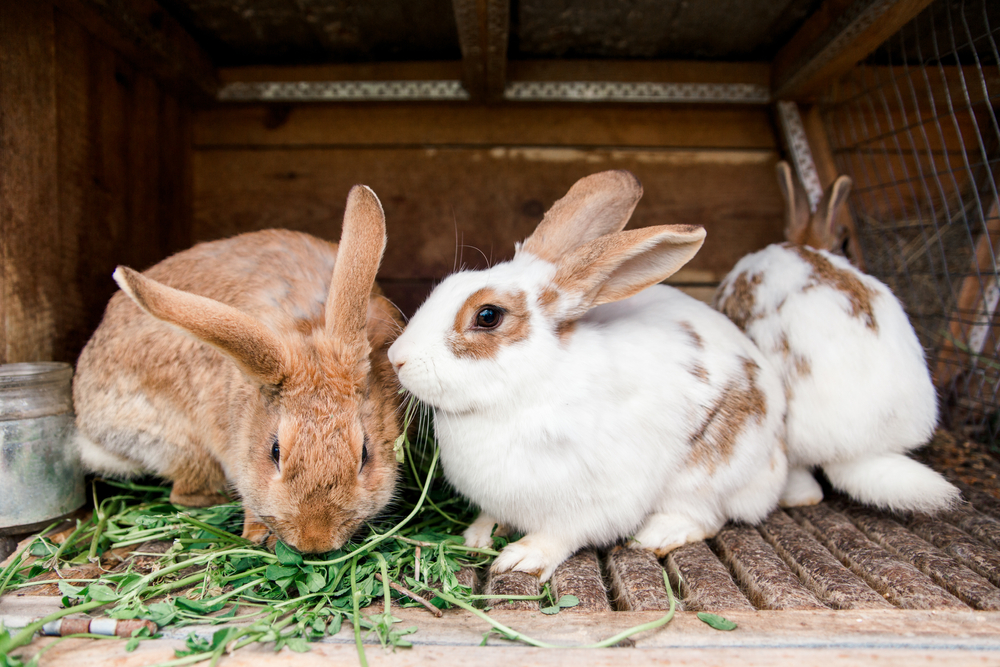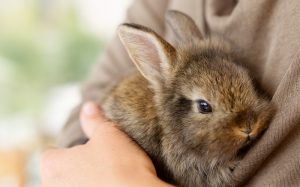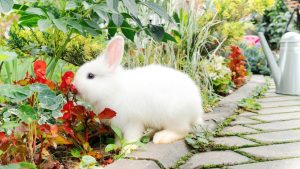
Rabbits are adorable pets, but they need to be cared for properly if you want them to live long, healthy lives. In this article, we’re going to tell you how to take care of a rabbit, so you know exactly what you’re doing.
We’ll talk about building the perfect home for your pet rabbit, how to feed your rabbit, and also give you a few invaluable tips that you should know if you want to keep a rabbit as a pet.
Making A Home For Your Rabbit
Pet rabbits can be either kept indoors in a cage, or outdoors in a secure and well ventilated rabbit hatch. Unlike wild rabbits, domestic rabbits can get sick if the temperature is too hot. Rabbits are also prey animals, so they need to be protected from the many predators that may want to eat them.
Rabbits can be easily frightened or stressed out if they see or even smell a predator. Some pet rabbits have been known to have a heart attack if they get too frightened. So, you should keep your pet rabbit indoors so that it has a stress-free environment.

Be Mindful What Your Rabbit Is Chewing On
If you want to let your cute rabbit loose inside your house, then there are a few things that you need to take care of. Rabbits love to bite and chew things, so you should make sure that any electrical wires and outlets are protected. If your rabbit chews into an electrical wire, it could suffer severe injury from electric shock.
Rabbits aren’t very careful about what they chew on, so you should make sure that there isn’t anything around that could be toxic for them. Insecticides, pesticides, and cleaning supplies should be kept out of the reach of your rabbit.
If you have indoor plants, then you should know that some of them can also be toxic to your rabbit. Azalea, Lily of the Valley, Aloe Vera, Calla Lily, and Philodendron are known to be poisonous to rabbits. So, make sure you have none of these plants around when your rabbit is roaming free.
What Your Rabbit Cage Needs
If you keep your rabbit in a cage, then the cage should be at least five times larger than the rabbit, so it has plenty of room to move around. Also, make sure that the bottom of the cage isn’t wire because this can hurt your rabbit’s little feet. You can put a plastic sheet on the floor of the cage to make it rabbit-friendly.
Put a cardboard box inside the cage to serve as your rabbit’s bedroom. The box will be a safe place for the rabbit where it can relax or hide if it gets frightened by something. Make sure not to disturb your rabbit when it’s in the cardboard bedroom, so it feels that a box is a safe place.

Rabbits Love To Explore
Let your rabbit out for a few hours so it can run, jump, and explore. Getting some exercise is vital to keeping your rabbit healthy and strong. You can also play with your pet during exercise time. Just make sure that the place where you let your rabbit out is safe and friendly.
You should also keep a litter box inside your rabbit’s cage where it can do its business. Try not to use any kind of wood shavings for the litter box as they can be toxic for rabbits. Instead, use organic litters that are made of wood pulp, citrus, or paper. You can use newspaper for the litter as well, but it won’t be as absorbent as other materials.
Feeding Your Rabbit
Rabbits have a complex digestive system, and many problems can be caused by giving them inappropriate diets. Some foods are bad for your rabbit and some foods which promote the rabbit’s health. If you want to know how to take care of a rabbit, then you should know about the foods that are good for your rabbit.
Food That Rabbits will Love
Hay, or Timothy grass hay, to be precise, should be an essential part of a rabbit’s diet. A rabbit should have some hay available to eat at all times. The hay is good for the rabbit’s digestion as it contains necessary fiber.
Vegetables, especially dark leafy greens, are good for rabbits as well. Leaf lettuces, dandelion greens, and parsley are some easy-to-find dark leafy greens. When you give a new vegetable to your rabbit for the first time, make sure that it’s in a small quantity so that the rabbit gives it a try.
There are some fruits that are good for rabbits too. Apples, pears, melons, peaches, and papaya are some fruits that you can feed to your furry friend. Fruits that have a high sugar content – like bananas, raisins, and grapes – should be given more sparingly to your pet.

What NOT To Feed Your Rabbit
Some foods which you should avoid giving your rabbit include iceberg lettuce, cabbage, beans, potatoes, onions, any grains, corn, peas, tomatoes, and rhubarb. Also, avoid feeding your rabbit sweets and chocolates. If you’re not sure if you should feed something to your pet, then ask your veterinarian first – just to be safe.
Rabbit Supplements
Pellets can also be used as supplements to the rabbit’s diet. Try to find Timothy-based pellets, and don’t give your rabbit more than ⅛ of a cup for every 5 pounds of the rabbit’s weight. Just remember that pellets shouldn’t replace the other items on a rabbit’s diet. They should only be given as supplements.
Water, Water, Water
And don’t forget to make sure that your rabbit always has some clean water to drink. You should change the water every day to keep it fresh. If you’re putting the water in a bowl, try to make sure it’s heavy enough that it doesn’t tip over.

A Few Other Tips When Dealing With Pet Rabbits
You can also give your rabbit some toys to play with, like balls and rings made from willow wood. Rabbits also love to chew to keep their teeth healthy, so give your pet some cardboard or toilet-paper rolls to chew.
And if you want to pick up your rabbit, then you should know that rabbits have very delicate bones. So, pick up your pet gently. You shouldn’t ever pick the rabbit up by the stomach or the ears.
Also, take your rabbit to the vet once a year for a regular check-up to see if it’s doing ok. Rabbits are social animals, so try to give your pet rabbit some company if you can. Having another rabbit around means your pet will have someone to play with and talk to.
Frequently Asked Questions
How often should I feed my rabbit?
You should generally feed your bunny twice a day. Always make sure that the food bowls are clean and fresh, and don’t give your pet more than 1/8 of a cup for every 5 pounds of its weight.
Can I let my rabbit run free in the house?
Rabbits are very curious and they love to explore new places, so you can certainly let your pet out of the cage. Just make sure that there aren’t any dangerous items in the room with it.
How much exercise does my rabbit need?
Your pet rabbit will get enough exercise just by running around in its cage, but if it’s an indoor/outdoor rabbit, you can try letting it out to play in a secure yard. But always make sure to keep an eye on the rabbit when it’s frolicking around outside.
Why does my rabbit sometimes hiss at me?
Rabbits are very territorial animals, so when your pet is making that noise, then it’s trying to tell you to keep your distance. It has nothing to do with you as a person, and it doesn’t mean that your rabbit doesn’t like you.






